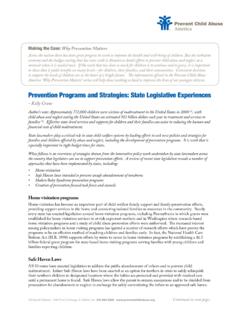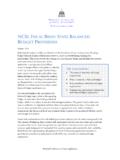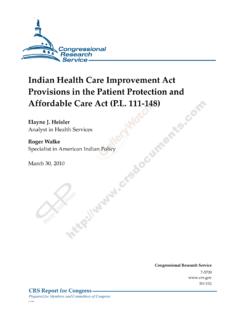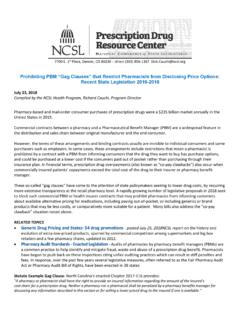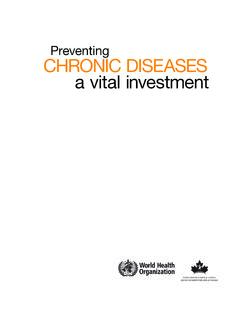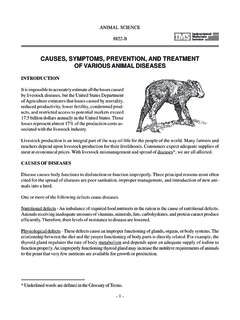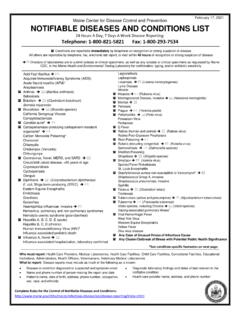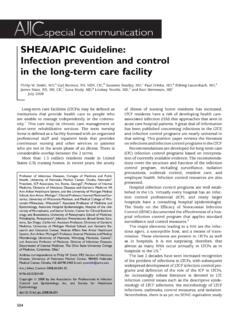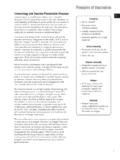Transcription of Chronic Disease Prevention and Management
1 Chronic Disease Prevention and ManagementChronic Disease Prevention and ManagementHealth Care Safety-Net Toolkit for LegislatorsChronic Disease Prevention and Management2 IntroductionChronic diseases are among the most prevalent and costly health conditions in the United States. Nearly half of Americans suffer from at least one Chronic condition, and the number is growing. Chronic diseases such as cancer, diabetes, hypertension, stroke, heart Disease , respiratory diseases, arthritis, obesity, and oral dis-eases can lead to hospitalization, long-term disability, reduced quality of life and, often, In fact, such persistent condi-tions are the nation s leading causes of death and disability. According to the Centers for Disease control and Prevention , more than two-thirds of deaths in the United States are the result of Chronic diseases.
2 Heart Disease , cancer, respiratory diseases and stroke are the leading killers of Americans; the top two alone account for nearly half of all deaths annually. Diabetes is on the rise among Americans, and follows close behind as the seventh leading cause of The prevalence of Chronic Disease has increased steadily among people of all ages in recent years. At the turn of the century, 125 million Americans had at least one Chronic condition; by 2005, that What Is Chronic Disease ?A Chronic Disease is generally considered a condition that lasts one year or more, requires ongoing medical attention and/or limits a person s daily Some of the most common Chronic condi-tions are listed below. Heart Disease Hypertension (high blood pressure) Stroke Cancernumber had grown to 133 million, and by 2020, experts project that 157 million will be These diseases affect more than one in two adults and more than one in four children in the United States.
3 More than 25 percent live with multiple Chronic The incidence of multiple, concurrent diseases is also on the People with multiple Chronic conditions have more complicat-ed health needs than their peers adding another layer of complexity and cost to their health care. Due to the nation s rapidly aging population and a nationwide increase in risk factors for Chronic Disease such as obesity this trend shows no sign of Chronic respiratory diseases Diabetes Arthritis AsthmaHealth Care Safety-Net Toolkit for Legislators3 What Legislators Need to Know About Chronic Disease Chronic diseases and conditions are the leading cause of death and disability in the United States, causing seven in 10 deaths Approximately one quarter of Americans live with a dis-ability caused by a Chronic illness.
4 Many Chronic diseases are among the most preventable of all health problems. Seventy-five percent of health care spending in the United States goes to treat Chronic conditions. This figure is even higher for Medicaid, where 80 cents of every $1 is spent on Chronic Heart Disease and cancer account for 47 percent of all deaths. Chronic Disease affects the majority of Americans: 51 percent of adults have at least one Chronic condition, and 26 percent live with multiple Chronic diseases. The number of people with Chronic conditions is increasing rapidly; by 2020, an estimated 47 percent of the nation s population will have a Chronic Significant racial, ethnic and geographic disparities exist in the prevalence of Chronic Disease . Numerous policy options are available to states that are interested in preventing and managing Chronic Disease to improve health and reduce costs.
5 Chronic Disease Prevention and Management4 Cost ImplicationsThe rise in Chronic diseases not only has serious consequences for the nation s health and health care systems, but also significantly contributes to health care Seventy-five percent of health care spending goes to treat people who have Chronic diseases. In Medicaid, too, beneficiaries who have complex needs significantly influence health care costs and account for an even larger portion of The economic effects of Chronic Disease extend beyond the cost of health care. The increasing prevalence of Chronic diseases reduces economic productivity through higher rates of absenteeism and poor job performance. A study by the Milken Institute, a nonpartisan think tank, found that the seven most common Chronic diseases can-cer, diabetes, hypertension, stroke, heart Disease , respiratory conditions, and mental disorders cost the economy nearly $ trillion annually, including $277 billion for treating Chronic condi-tions and $1 trillion in lost The study also found that minimal changes in un-healthy behaviors could prevent or delay Chronic conditions and reduce these costs, although exactly how much can be saved and over what time period are subject to debate.
6 Policy Options for Prevention and Management of Chronic DiseaseThe debilitating, costly effects of Chronic condi-tions often can be prevented, delayed or mitigated. Numerous policies and programs are available to help state policymakers prevent and manage Chronic diseases among their constituents. The fol-lowing overview highlights various options some states have undertaken in an attempt to improve health and/or reduce the cost of health care and Chronic access to a full range of quality health services for those with Chronic conditions Access to comprehensive, quality health services is important for everyone, but even more critical for those who have Chronic conditions. Access to care can improve Prevention , detection and treatment of Chronic health conditions, yet many people face significant barriers to accessing More than 45 million Americans currently lack health insurance, countless more are deterred by the high cost of care, and others live in communities where services are difficult to access or Studies indicate nearly one-third of uninsured, working-age adults have at least one Chronic The 2010 Affordable Care Act (ACA) aims to improve access to health insurance through estab-lishment of Health Insurance Exchanges and the optional Medicaid expansion.
7 Federally Qualified Health Centers (FQHCs) also enhance access by providing primary medical, dental, behavioral and social services to people who lack access to care, including the uninsured, residents of rural and underserved areas, and many Medicaid patients. Community health centers pro-vide services regardless of an individual s ability to pay and are well-equipped to address the needs of people with Chronic conditions. In fact, patients of health centers are more than three times as likely to seek care for Chronic conditions as patients who receive care in other primary care Legislators may wish to consider the following policy options to help ensure access to a full range of quality health services for people with Chronic diseases. Adjust state funding to support community health centers.
8 Many states support health Health Care Safety-Net Toolkit for Legislators5centers through general fund appropriations or tobacco settlement funds. Support measures that increase the number of people with health coverage, such as strength-ening employer-sponsored insurance, support-ing health insurance exchange outreach and enrollment, supporting Medicaid and CHIP coverage and more. Support health care workforce initiatives. Loan repayment programs and other incen-tives address clinical workforce shortages by supporting primary care providers who prac-tice in underserved areas. Review facility licensure laws. Exempt certain providers, such as rural health centers, from specific laws or regulations to make it easier for them to operate in underserved areas. Review health professional licensing and scope of practice laws.
9 Create policies that allow primary care providers to practice to the full extent of their training. Encourage Medicaid reimbursement for oral, behavioral and other health services. Support other, evidence-based policies that aim to lower the cost and improve the quality of health care. Support establishment of medical and health homesDesigned to meet patient needs, the patient-centered medical home or health home model of care aims to improve access to and coordina-tion of patient care. The model consists of a team of health care providers such as physicians, nurses, nutritionists, pharmacists, community health workers and social workers who focus on a person s overall health and provide coordinated, comprehensive care for those whose needs are complex, such as people with Chronic conditions.
10 Medical homes coordinate care across health, be-havioral, community and long-term services; offer extended office hours and enhanced communica-tion between providers and patients to improve access to care; and educate patients about how best to manage their conditions. This delivery system not only offers an opportunity for states to reduce costs and improve care for the chronically ill, but also reflects states movement toward support of team-based health care. Legislators may want to consider the follow-ing policy options to support the medical home model. Adopt policies and programs to advance medi-cal homes. As of April 2013, 43 states were planning or implementing the medical home model for certain Medicaid or CHIP benefi-ciaries. Many focus on people with Chronic conditions and other high-cost Support payment reform.
